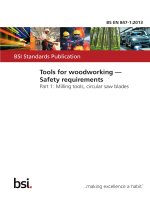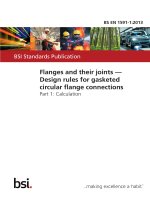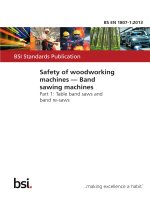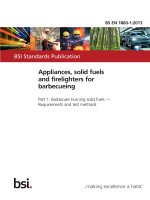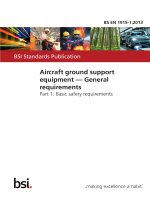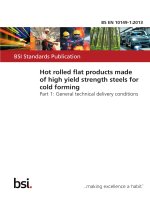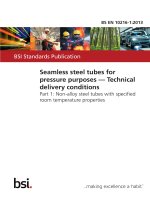Bsi bs en 60216 1 2013
Bạn đang xem bản rút gọn của tài liệu. Xem và tải ngay bản đầy đủ của tài liệu tại đây (1.25 MB, 38 trang )
BS EN 60216-1:2013
BSI Standards Publication
Electrical insulating
materials — Thermal
endurance properties
Part 1: Ageing procedures and
evaluation of test results
BS EN 60216-1:2013
BRITISH STANDARD
National foreword
This British Standard is the UK implementation of EN 60216-1:2013.
It is identical to IEC 60216-1:2013. Together with BS EN 60216-8:2013, it
supersedes BS EN 60216-1:2002 which is withdrawn.
The “simplified method” has been removed from IEC 60216-1:2002 in the
new edition (IEC 60216-1:2013) and now forms IEC 60216-8:2013,
“Instructions for calculating thermal endurance characteristics using
simplified procedures”.
The UK participation in its preparation was entrusted to Technical
Committee GEL/112, Evaluation and qualification of electrical insulating
materials and systems.
A list of organizations represented on this committee can be obtained
on request to its secretary.
This publication does not purport to include all the necessary provisions
of a contract. Users are responsible for its correct application.
© The British Standards Institution 2013.
Published by BSI Standards Limited 2013
ISBN 978 0 580 79005 8
ICS 17.220.99; 29.035.01
Compliance with a British Standard cannot confer immunity from
legal obligations.
This British Standard was published under the authority of the Standards
Policy and Strategy Committee on 30 September 2013.
Amendments/corrigenda issued since publication
Date
Text affected
BS EN 60216-1:2013
EN 60216-1
EUROPEAN STANDARD
NORME EUROPÉENNE
EUROPÄISCHE NORM
July 2013
ICS 17.220.99; 29.035.01
English version
Electrical insulating materials Thermal endurance properties Part 1: Ageing procedures and evaluation of test results
(IEC 60216-1:2013)
Matériaux isolants électriques Propriétés d'endurance thermique Partie 1: Méthodes de vieillissement
et évaluation des résultats d'essai
(CEI 60216-1:2013)
Elektroisolierstoffe Eigenschaften hinsichtlich des
thermischen Langzeitverhaltens Teil 1: Warmlagerungsverfahren und
Auswertung von Prüfergebnissen
(IEC 60216-1:2013)
This European Standard was approved by CENELEC on 2013-04-19. CENELEC members are bound to comply
with the CEN/CENELEC Internal Regulations which stipulate the conditions for giving this European Standard
the status of a national standard without any alteration.
Up-to-date lists and bibliographical references concerning such national standards may be obtained on
application to the CEN-CENELEC Management Centre or to any CENELEC member.
This European Standard exists in three official versions (English, French, German). A version in any other
language made by translation under the responsibility of a CENELEC member into its own language and notified
to the CEN-CENELEC Management Centre has the same status as the official versions.
CENELEC members are the national electrotechnical committees of Austria, Belgium, Bulgaria, Croatia, Cyprus,
the Czech Republic, Denmark, Estonia, Finland, Former Yugoslav Republic of Macedonia, France, Germany,
Greece, Hungary, Iceland, Ireland, Italy, Latvia, Lithuania, Luxembourg, Malta, the Netherlands, Norway, Poland,
Portugal, Romania, Slovakia, Slovenia, Spain, Sweden, Switzerland, Turkey and the United Kingdom.
CENELEC
European Committee for Electrotechnical Standardization
Comité Européen de Normalisation Electrotechnique
Europäisches Komitee für Elektrotechnische Normung
Management Centre: Avenue Marnix 17, B - 1000 Brussels
© 2013 CENELEC -
All rights of exploitation in any form and by any means reserved worldwide for CENELEC members.
Ref. No. EN 60216-1:2013 E
BS EN 60216-1:2013
EN 60216-1:2013
-2-
Foreword
The text of document 112/235/FDIS, future edition 6 of IEC 60216-1, prepared by IEC/TC 112
"Evaluation and qualification of electrical insulating materials and systems" was submitted to the
IEC-CENELEC parallel vote and approved by CENELEC as EN 60216-1:2013.
The following dates are fixed:
•
latest date by which the document has
to be implemented at national level by
publication of an identical national
standard or by endorsement
(dop)
2014-01-19
•
latest date by which the national
standards conflicting with the
document have to be withdrawn
(dow)
2016-04-19
This document supersedes EN 60216-1:2001 (PART).
EN 60216-1:2013 includes the following significant changes with respect to EN 60216-1:2001:
This edition constitutes an editorial revision where the simplified method has been removed and now
forms Part 8 of the EN 60216 Series: Instructions for calculating thermal endurance characteristics
using simplified procedures.
Attention is drawn to the possibility that some of the elements of this document may be the subject of
patent rights. CENELEC [and/or CEN] shall not be held responsible for identifying any or all such
patent rights.
Endorsement notice
The text of the International Standard IEC 60216-1:2013 was approved by CENELEC as a European
Standard without any modification.
In the official version, for Bibliography, the following notes have to be added for the standards indicated:
ISO 291
NOTE
Harmonised as EN ISO 291.
ISO 2578:1993
NOTE
Harmonised as EN ISO 2578:1998 (not modified).
BS EN 60216-1:2013
EN 60216-1:2013
-3-
Annex ZA
(normative)
Normative references to international publications
with their corresponding European publications
The following documents, in whole or in part, are normatively referenced in this document and are
indispensable for its application. For dated references, only the edition cited applies. For undated
references, the latest edition of the referenced document (including any amendments) applies.
NOTE When an international publication has been modified by common modifications, indicated by (mod), the relevant EN/HD
applies.
Publication
Year
Title
EN/HD
Year
IEC 60212
-
Standard conditions for use prior to and
during the testing of solid electrical
insulating materials
EN 60212
-
IEC 60216-2
-
Electrical insulating materials - Thermal
EN 60216-2
endurance properties Part 2: Determination of thermal endurance
properties of electrical insulating materials Choice of test criteria
-
IEC 60216-3
+ corr. December
2006
2009
Electrical insulating materials - Thermal
endurance properties Part 3: Instructions for calculating thermal
endurance characteristics
EN 60216-3
2006
IEC 60216-4
Series Electrical insulating materials - Thermal
endurance properties
EN 60216-4
Series
IEC 60216-4-1
-
Electrical insulating materials - Thermal
endurance properties Part 4-1: Ageing ovens - Single-chamber
ovens
EN 60216-4-1
-
IEC 60216-8
2013
Electrical insulating materials - Thermal
endurance properties Part 8: Instructions for calculating thermal
endurance characteristics using simplified
procedures
EN 60216-8
2013
IEC 60493-1
2011
Guide for the statistical analysis of ageing
test data Part 1: Methods based on mean values of
normally distributed test results
-
-
–2–
BS EN 60216-1:2013
60216-1 © IEC:2013
CONTENTS
INTRODUCTION ..................................................................................................................... 6
1
Scope ............................................................................................................................... 7
2
Normative references ....................................................................................................... 7
3
Terms, definitions, symbols and abbreviations .................................................................. 8
4
3.1 Terms and definitions .............................................................................................. 8
3.2 Symbols and abbreviations .................................................................................... 10
Synopsis of procedures – Full procedures ...................................................................... 11
5
Detailed experimental procedures .................................................................................. 11
5.1
6
Selection of test procedures .................................................................................. 11
5.1.1 General considerations .............................................................................. 11
5.1.2 Selection of test properties for TI ............................................................... 11
5.1.3 Determination of TI for times other than 20 000 h ...................................... 12
5.2 Selection of end-points .......................................................................................... 12
5.3 Preparation and number of test specimens ............................................................ 12
5.3.1 Preparation ................................................................................................ 12
5.3.2 Number of specimens ................................................................................ 13
5.4 Establishment of initial property value ................................................................... 14
5.5 Exposure temperatures and times ......................................................................... 14
5.6 Ageing ovens ........................................................................................................ 14
5.7 Environmental conditions ...................................................................................... 15
5.7.1 General ..................................................................................................... 15
5.7.2 Atmospheric conditions during ageing ....................................................... 15
5.7.3 Conditions for property measurement ........................................................ 15
5.8 Procedure for ageing ............................................................................................. 15
5.8.1 General ..................................................................................................... 15
5.8.2 Procedure using a non-destructive test ...................................................... 15
5.8.3 Procedure using a proof test ...................................................................... 16
5.8.4 Procedure using a destructive test ............................................................. 16
Evaluation ...................................................................................................................... 16
6.1
6.2
6.3
6.4
6.5
6.6
Numerical analysis of test data .............................................................................. 16
Thermal endurance characteristics and formats ..................................................... 17
Times to end-point, x- and y-values ....................................................................... 18
6.3.1 General ..................................................................................................... 18
6.3.2 Non-destructive tests ................................................................................. 18
6.3.3 Proof tests ................................................................................................. 19
6.3.4 Destructive tests ........................................................................................ 19
Means and variances ............................................................................................ 21
6.4.1 Complete data ........................................................................................... 21
6.4.2 Incomplete (censored) data ....................................................................... 22
General means and variances and regression analysis.......................................... 22
Statistical tests and data requirements .................................................................. 22
6.6.1 General ..................................................................................................... 22
6.6.2 Data of all types ........................................................................................ 22
6.6.3 Proof tests ................................................................................................. 23
6.6.4 Destructive tests ........................................................................................ 23
BS EN 60216-1:2013
60216-1 © IEC:2013
–3–
6.7 Thermal endurance graph and thermal endurance characteristics ......................... 24
6.8 Test report ............................................................................................................ 24
Annex A (informative) Dispersion and non-linearity .............................................................. 26
Annex B (informative) Exposure temperatures and times ..................................................... 28
Annex C (informative) Concepts in earlier editions ............................................................... 31
Bibliography .......................................................................................................................... 33
Figure 1 – Thermal endurance graph .................................................................................... 17
Figure 2 – Property variation – Determination of time to end-point at each temperature
(destructive and non-destructive tests) ................................................................................. 19
Figure 3 – Estimation of times to end-point – Property value (ordinate, arbitrary units)
versus time (abscissa, log scale, arbitrary units) ................................................................... 20
Figure 4 – Destructive tests – Estimation of time to end-point ............................................... 21
Figure C.1 – Relative temperature index (Adapted from Figure 3, IEC 60216-1:1990,
4th edition) ........................................................................................................................... 32
Table 1 – Suggested exposure temperatures and times ........................................................ 25
Table B.1 – Groups ............................................................................................................... 29
–6–
BS EN 60216-1:2013
60216-1 © IEC:2013
INTRODUCTION
The listing of the thermal capabilities of electrical insulating materials, based on service
experience, was found to be impractical, owing to the rapid development of polymer and
insulation technologies and the long time necessary to acquire appropriate service
experience. Accelerated ageing and test procedures were therefore required to obtain the
necessary information. The IEC 60216 series has been developed to formalize these
procedures and the interpretation of their results.
Physico-chemical models postulated for the ageing processes led to the almost universal
assumption of the Arrhenius equations to describe the rate of ageing. Out of this arose
the concept of the temperature index (TI) as a single-point characteristic based upon
accelerated ageing data. This is the numerical value of the temperature in °C at which the
time taken for deterioration of a selected property to reach an accepted end-point is that
specified (usually 20 000 h).
NOTE The term Arrhenius is widely used (and understood) to indicate a linear relationship between the logarithm
of a time and the reciprocal of the thermodynamic (absolute or Kelvin) temperature. The correct usage is restricted
to such a relationship between a reaction rate constant and the thermodynamic temperature. The common usage is
employed throughout this standard.
The large statistical scatter of test data which was found, together with the frequent
occurrence of substantial deviations from the ideal behavior, demonstrated the need for tests
to assess the validity of the basic physico-chemical model. The application of conventional
statistical tests, as set out in IEC 60493-1, fulfilled this requirement, resulting in the
"confidence limit", (TC) of TI, but the simple, single-point TI was found inadequate to describe
the capabilities of materials. This led to the concept of the "Thermal Endurance Profile" (TEP),
incorporating the temperature index, its variation with specified ageing time, and a confidence
limit.
A complicating factor is that the properties of a material subjected to thermal ageing may not
all deteriorate at the same rate, and different end-points may be relevant for different
applications. Consequently, a material may be assigned more than one temperature index,
derived, for example, from the measurement of different properties and the use of different
end-point times.
It was subsequently found that the statistical confidence index included in the TEP was not
widely understood or used. However, the statistical tests were considered essential,
particularly after minor modifications to make them relate better to practical circumstances:
the concept of the halving interval (HIC) was introduced to indicate the rate of change of
ageing time with temperature. TEP was then abandoned, with the TI and HIC being reported
in a way which indicated whether or not the statistical tests had been fully satisfied. At the
same time, the calculation procedures were made more comprehensive, enabling full
statistical testing of data obtained using a diagnostic property of any type, including the
particular case of partially incomplete data. Simultaneously with the development of the
IEC 60216 series, other standards were being developed in ISO, intended to satisfy a similar
requirement for plastics and rubber materials. These are ISO 2578 and ISO 11346
respectively, which use less rigorous statistical procedures and more restricted experimental
techniques. A simplified calculation procedure is described in IEC 60216-8.
BS EN 60216-1:2013
60216-1 © IEC:2013
–7–
ELECTRICAL INSULATING MATERIALS –
THERMAL ENDURANCE PROPERTIES –
Part 1: Ageing procedures and evaluation of test results
1
Scope
This part of IEC 60216 specifies the general ageing conditions and procedures to be used for
deriving thermal endurance characteristics and gives guidance in using the detailed
instructions and guidelines in the other parts of the standard.
Although originally developed for use with electrical insulating materials and simple
combinations of such materials, the procedures are considered to be of more general
applicability and are widely used in the assessment of materials not intended for use as
electrical insulation.
In the application of this standard, it is assumed that a practically linear relationship exists
between the logarithm of the time required to cause the predetermined property change and
the reciprocal of the corresponding absolute temperature (Arrhenius relationship).
For the valid application of the standard, no transition, in particular no first-order transition
should occur in the temperature range under study.
Throughout the rest of this standard the term "insulating materials" is always taken to mean
"insulating materials and simple combinations of such materials".
2
Normative references
The following documents, in whole or in part, are normatively referenced in this document and
are indispensable for its application. For dated references, only the edition cited applies. For
undated references, the latest edition of the referenced document (including any
amendments) applies.
IEC 60212, Standard conditions for use prior to and during the testing of solid electrical
insulating materials
IEC 60216-2, Electrical insulating materials – Thermal endurance properties – Part 2:
Determination of thermal endurance properties of electrical insulating materials – Choice of
test criteria
IEC 60216-3:2006, Electrical insulating materials – Thermal endurance properties – Part 3:
Instructions for calculating thermal endurance characteristics
IEC 60216-4 (all Parts 4), Electrical insulating materials – Thermal endurance properties –
Part 4: Ageing ovens
IEC 60216-4-1, Electrical insulating materials – Thermal endurance properties – Part 4-1:
Ageing ovens – Single-chamber ovens
IEC 60216-8, Electrical insulating materials – Thermal endurance properties – Part 8:
Instructions for calculating thermal endurance characteristics using simplified procedures 1
––––––––
1
To be published.
BS EN 60216-1:2013
60216-1 © IEC:2013
–8–
IEC 60493-1:2011, Guide for the statistical analysis of ageing test data – Part 1: Methods
based on mean values of normally distributed test results
3
3.1
Terms, definitions, symbols and abbreviations
Terms and definitions
For the purposes of this document, the following terms and definitions apply:
3.1.1
temperature index
TI
numerical value of the temperature in degrees Celsius derived from the thermal endurance
relationship at a time of 20 000 h (or other specified time)
3.1.2
halving interval
HIC
numerical value of the temperature interval in Kelvin which expresses the halving of the time
to end-point taken at the temperature equal to TI
[SOURCE: IEC 60050-212:2010, definition 212-12-13, modified – "equal to TI" replaces
"corresponding to the temperature index or the relative temperature index"]
3.1.3
thermal endurance graph
graph in which the logarithm of the time to reach a specified end-point in a thermal endurance
test is plotted against the reciprocal thermodynamic (absolute) test temperature
[SOURCE: IEC 60050-212:2010,
"(absolute)"]
definition
212-12-10,
modified
–
"insertion
of
word
3.1.4
thermal endurance graph paper
graph paper having a logarithmic time scale as the ordinate, graduated in powers of ten
(from 10 h to 100 000 h is often a convenient range)
Note 1 to entry: Values of the abscissa are proportional to the reciprocal of the thermodynamic (absolute)
temperature. The abscissa is usually graduated in a non-linear (Celsius) temperature scale oriented with
temperature increasing from left to right.
3.1.5
ordered data
set of data arranged in sequence so that, in the appropriate direction through the sequence,
each member is greater than, or equal to, its predecessor
Note 1 to entry: Ascending order in this standard implies that the data is ordered in this way, the first orderstatistic being the smallest.
3.1.6
order-statistics
each individual value in a set of ordered data is referred to as an order-statistics identified by
its numerical position in the sequence
3.1.7
incomplete data
ordered data, where the values above and/or below defined points are not known
BS EN 60216-1:2013
60216-1 © IEC:2013
–9–
3.1.8
censored data
incomplete data, where the number of unknown values is known
Note 1 to entry: If the censoring is begun above/below a specified numerical value, the censoring is of type 1.
If above/below a specified order-statistic, it is of type 2. This standard is concerned only with type 2.
3.1.9
degrees of freedom
number of data values minus the number of parameter values
3.1.10
variance of a data set
sum of the squares of the deviations of the data from a reference level defined by one or more
parameters, divided by the number of degrees of freedom
Note 1 to entry: The reference level may for example, be a mean value (one parameter) or a line (two parameters,
slope and intercept).
3.1.11
covariance of data sets
for two sets of data with equal numbers of elements where each element in one set
corresponds to one in the other, the sum of the products of the deviations of the corresponding members from their set means, divided by the number of degrees of freedom
3.1.12
regression analysis
process of deducing the best-fit line expressing the relation of corresponding members of two
data groups by minimizing the sum of squares of deviations of members of one of the groups
from the line
Note 1 to entry:
The parameters are referred to as the regression coefficients.
3.1.13
correlation coefficient
number expressing the completeness of the relation between members of two data sets, equal
to the covariance divided by the square root of the product of the variances of the sets
Note 1 to entry:
The value of its square is between 0 (no correlation) and 1 (complete correlation).
3.1.14
confidence limit
TC
statistical parameter, calculated from the test data, which with 95 % confidence constitutes a
lower limit for the true value of the temperature index estimated by TI
Note 1 to entry: 95 % confidence implies that there is only 5 % probability that the true value of the temperature
index is actually smaller than TC.
Note 2 to entry: In other connections, confidence values other than 95 % may sometimes be used; for example, in
the linearity test for destructive test data.
3.1.15
destructive test
diagnostic property test, where the test specimen is irreversibly changed by the property
measurement, in a way which precludes a repeated measurement on the same specimen
– 10 –
BS EN 60216-1:2013
60216-1 © IEC:2013
3.1.16
non-destructive test
diagnostic property test, where the properties of the test specimen are not permanently
changed by the measurement, so that a further measurement on the same specimen may be
made after appropriate treatment
3.1.17
proof test
diagnostic property test, where each test specimen is, at the end of each ageing cycle,
subjected to a specified stress, further ageing cycles being conducted until the specimen fails
on testing
3.1.18
temperature group
test group of specimens
number of specimens being exposed together to the same temperature ageing in the same
oven
Note 1 to entry: Where there is no risk of ambiguity, either temperature groups or test groups may be referred to
simply as groups.
3.1.19
test group
test group of specimens
number of specimens removed together from a temperature group (as above) for destructive
testing
3.1.20
end point
property level that is effected by practical application to the equipment in the thermal
endurance test
3.2
Symbols and abbreviations
Symbol
Meaning
a,b
Regression coefficients
n a,b,c,d
Numbers of specimens for destructive tests
n
Number of y-values
N
Total number of test specimens
mi
Number of specimens in temperature group i (censored data)
r
Correlation coefficient
F
Fisher distributed stochastic variable
x
Reciprocal thermodynamic temperature (1/ Θ )
y
Logarithm of time to end-point
ϑ
Temperature, °C
Θ
Temperature, thermodynamic (Kelvin)
Θ0
Value in Kelvin (0 °C = 273,15 K)
τ
Time (to end-point)
χ2
χ 2 -distributed stochastic variable
TI
Temperature index
TC
Lower 95 % confidence limit of TI
HIC
Halving interval at temperature equal to TI
RTI
Relative temperature index
BS EN 60216-1:2013
60216-1 © IEC:2013
4
– 11 –
Synopsis of procedures – Full procedures
The standardized procedure for the evaluation of thermal properties of a material consists of a
sequence of steps, as follows.
It is strongly recommended that the full evaluation procedure, as described below and in 5.1
to 5.8, be used.
a) Prepare suitable specimens appropriate for the intended property measurements
(see 5.3).
b) Subject groups of specimens to ageing at several fixed levels of elevated temperature,
either continuously, or cyclically for a number of periods between which the specimens are
normally returned to room temperature or another standard temperature (see 5.5).
c) Subject specimens to a diagnostic procedure in order to reveal the degree of ageing.
Diagnostic procedures may be non-destructive or destructive determinations of a property
or potentially destructive proof tests (see 5.1 and 5.2).
d) Extend the continuous heat exposure or the thermal cycling until the specified end-point,
i.e. failure of specimens or a specified degree of change in the measured property, is
reached (see 5.1, 5.2 and 5.5).
e) Report the test results, showing the kind of ageing procedure (continuous or cyclic) and
diagnostic procedure (see under item c) above); the ageing curves, or time or number of
cycles to reach the end-point, for each specimen.
f)
Evaluate these data numerically and present them graphically, as explained in 6.1
and 6.8.
g) Express the complete information in abbreviated numerical form, as described in 6.2 by
means of the temperature index and halving interval.
The full experimental and evaluation procedures are given in Clause 5 and as far as 6.8.
A simplified procedure is given in IEC 60216-8.
5
Detailed experimental procedures
5.1
5.1.1
Selection of test procedures
General considerations
Each test procedure should specify the shape, dimensions and number of the test specimens,
the temperatures and times of exposure, the property to which TI is related, the methods of its
determination, the end-point, and the derivation of the thermal endurance characteristics from
the experimental data.
The chosen property should reflect, in a significant fashion if possible, a function of the
material in practical use. A choice of properties is given in IEC 60216-2.
To provide uniform conditions, the conditioning of specimens after removal from the oven and
before measurement may need to be specified.
5.1.2
Selection of test properties for TI
If IEC material specifications are available, property requirements in terms of acceptable
lower limits of TI values are usually given. If such material specifications are not available, a
selection of properties and methods for the evaluation of thermal endurance is given in
IEC 60216-2. (If such a method cannot be found, an international, national, or institution
standard, or a specially devised method should be used, and in that order of preference.)
– 12 –
5.1.3
BS EN 60216-1:2013
60216-1 © IEC:2013
Determination of TI for times other than 20 000 h
In the majority of cases, the required thermal endurance characteristics are for a projected
duration of 20 000 h. However, there is often a need for such information related to other
longer or shorter times. In cases of longer times, for example, the times given as
requirements or recommendations in the text of this standard (for example, 5 000 h for the
minimum value of the longest time to end-point) shall be increased in the ratio of the actual
specification time to 20 000 h. In the same way, the ageing cycle durations should be
changed in approximately the same ratio. The temperature extrapolation again shall not
exceed 25 K. In cases of shorter specification times, the related times may be decreased in
the same ratio if necessary.
Particular care will be needed for very short specification times, since the higher ageing
temperatures may lead into temperature regions which include transition points, for example,
glass transition temperature or partial melting, with consequent non-linearity. Very long
specification times may also lead to non-linearity (see also Annex A).
5.2
Selection of end-points
The thermal endurance of materials may need to be characterized by different endurance data
(derived using different properties and/or end-points), in order to facilitate the adequate
selection of the material in respect of its particular application in an insulation system. See
IEC 60216-2.
There are two alternative ways in which the end-point may be defined:
a) As a percentage increase or decrease in the measured value of the property from the
original level. This approach will provide comparisons among materials but bears a poorer
relationship than item b) to the property values required in normal service. For the
determination of the initial value, see 5.4.
b) As a fixed value of the property. This value might be selected with respect to usual service
requirements. End-points of proof tests are predominantly given in the form of fixed values
of the property.
The end-point should be selected to indicate a degree of deterioration of the insulating
material which has reduced its ability to withstand a stress encountered in actual service in an
insulation system. The degree of degradation indicated as the end-point of the test should be
related to the allowable safe value for the material property which is desired in practice.
5.3
5.3.1
Preparation and number of test specimens
Preparation
The specimens used for the ageing test should constitute a random sample from the
population investigated and are to be treated uniformly.
The material specifications or the test standards will contain all necessary instructions for the
preparation of specimens.
The thickness of specimens is in some cases specified in the list of property measurements
for the determination of thermal endurance. See IEC 60216-2. If not, the thickness shall be
reported. Some physical properties are sensitive even to minor variations of specimen
thickness. In such cases, the thickness after each ageing period may need to be determined
and reported if required in the relevant specification.
The thickness is also important because the rate of ageing may vary with thickness. Ageing
data of materials with different thicknesses are not always comparable. Consequently, a
material may be assigned more than one thermal endurance characteristic derived from the
measurement of properties at different thicknesses.
BS EN 60216-1:2013
60216-1 © IEC:2013
– 13 –
The tolerances of specimen dimensions should be the same as those normally used for
general testing; where specimen dimensions need smaller tolerances than those normally
used, these special tolerances should be given. Screening measurements ensure that
specimens are of uniform quality and typical of the material to be tested.
Since processing conditions may significantly affect the ageing characteristics of some
materials, it shall be ensured that, for example, sampling, cutting sheet from the supply roll,
cutting of anisotropic material in a given direction, molding, curing, pre-conditioning, are
performed in the same manner for all specimens.
5.3.2
5.3.2.1
Number of specimens
General
The accuracy of endurance test results depends largely on the number of specimens aged
at each temperature. Instructions for an adequate number of specimens are given in
IEC 60216-3. Generally, the following instructions (5.3.2.1 to 5.3.2.3), which influence the
testing procedure given in 5.8, shall apply.
It is good practice to prepare additional specimens, or at least to provide a reserve of the
original material batch from which such specimens may subsequently be prepared. In this
way, any required ageing of additional specimens in case of unforeseen complications will
introduce a minimum risk of producing systematic differences between groups of specimens.
Such complications may arise, for example, if the thermal endurance relationship turns out to
be non-linear, or if specimens are lost due to thermal runaway of an oven.
Where the test criterion for non-destructive or proof tests is based upon the initial value of the
property, this should be determined from a group of specimens of at least twice the number of
specimens in each temperature group. For destructive tests, see 5.3.2.4.
5.3.2.2
Number of specimens for non-destructive tests
For each exposure temperature, in most cases a group of five specimens will be adequate.
However, further guidance will be found in IEC 60216-3.
5.3.2.3
Number of specimens for proof tests
In most cases a group of at least 11 specimens for each exposure temperature will be
required. For graphical derivation and in some other cases the treatment of data may be
simpler if the number of specimens in each group is odd. Further guidance will be found in
IEC 60216-3.
5.3.2.4
Number of specimens for destructive tests
This number (N) is derived as follows: N = n a × n b × n c + n d
where
na
is the number of specimens in a test group undergoing identical treatment at one
temperature and discarded after determination of the property (usually five);
nb
is the number of treatments, i.e. total number of exposure times, at one temperature;
nc
is the number of ageing temperature levels;
nd
is the number of specimens in the group used to establish the initial value of the property.
Normal practice is to select n d = 2n a when the diagnostic criterion is a percentage change
of the property from its initial level. When the criterion is an absolute property level, n d is
usually given the value of zero, unless reporting of the initial value is required.
– 14 –
5.4
BS EN 60216-1:2013
60216-1 © IEC:2013
Establishment of initial property value
Select the specimens for the determination of the initial value of the property to constitute a
random subset of those prepared for ageing. Before determining the property value, these
specimens shall be conditioned by exposure to the lowest level of ageing temperature of the
test (see 5.5) for two days (48 h ± 6 h).
In some cases (for example, very thick specimens), times greater than two days may be
necessary to establish a stable value.
Unless otherwise stated in the method for determining the diagnostic property (for example,
parts of material specifications dealing with methods of test, or a method listed in
IEC 60216-2), the initial value is the arithmetic mean of the test results.
5.5
Exposure temperatures and times
For TI determinations, test specimens should be exposed to not less than three, preferably at
least four, temperatures covering a sufficient range to demonstrate a linear relationship
between time to end-point and reciprocal thermodynamic (absolute) temperature.
To reduce the uncertainties in calculating the appropriate thermal endurance characteristic,
the overall temperature range of thermal exposure needs to be carefully selected, observing
the following requirements (if the required thermal endurance characteristics are for a
projected duration of 20 000: see also 5.1.3):
a) the lowest exposure temperature shall be one which will result in a mean or median time
to end-point of more than 5 000 h when determining TI (see also 5.1.3);
b) the extrapolation necessary to establish TI shall not be more than 25 K;
c) the highest exposure temperature shall be one which will result in a mean or median time
to end-point of more than 100 h (if possible, less than 500 h).
For some materials, it is not possible to achieve a time to end-point of less than 500 h while
retaining satisfactory linearity. However, it is important that a smaller range of mean times to
end-point will lead to a larger confidence interval of the result for the same data dispersion.
Relevant and detailed instructions on how to proceed using non-destructive, proof or
destructive test criteria are provided in 5.8.
Table 1 gives guidance in making initial selections.
A number of recommendations and suggestions, useful in establishing times and temperatures, will be found in Annex B.
5.6
Ageing ovens
Throughout the heat ageing period, ageing ovens shall maintain, in that part of the working
space where specimens are placed, a temperature with tolerances as given in the
IEC 60216-4 series. Unless otherwise specified, IEC 60216-4-1 shall apply.
The circulation of the air within the oven and the exchange of the air content should be
adequate to ensure that the rate of thermal degradation is not influenced by accumulation of
decomposition products or oxygen depletion (see 5.7).
BS EN 60216-1:2013
60216-1 © IEC:2013
5.7
5.7.1
– 15 –
Environmental conditions
General
The effects of special environmental conditions such as extreme humidity, chemical
contamination or vibration in many cases may be more appropriately evaluated by insulation
systems tests. However, environmental conditioning, the influence of atmospheres other than
air and immersion in liquids such as oil may be important, but these are not the concern of
this standard.
5.7.2
Atmospheric conditions during ageing
Unless otherwise specified, ageing shall be carried out in ovens operating in the normal
laboratory atmosphere. However, for some materials very sensitive to the humidity in the
ovens, more reliable results are obtained when the absolute humidity in the ageing oven room
is controlled and equal to the absolute humidity corresponding to standard atmosphere B
according to IEC 60212. This, or other specified conditions, shall then be reported.
5.7.3
Conditions for property measurement
Unless otherwise specified, the specimens shall be conditioned before measurement and
measured under conditions as specified in the material standard specification.
5.8
5.8.1
Procedure for ageing
General
This subclause relates to the basic procedures for using
a) a non-destructive test,
b) a proof test,
c) a destructive test.
Prepare a number of specimens following the instructions in 5.3. If necessary, determine the
initial value of the property as specified in 5.4. Divide the specimens by random selection into
as many groups as there are exposure temperatures.
Establish the exposure temperatures and times in accordance with the instructions of 5.5 (see
also Annex B).
Place one group for exposure in each of the ovens complying with 5.6, maintained as closely
as possible to the temperatures selected from Table 1.
NOTE 1 It is suggested that individual specimens be identified to simplify their return to the correct oven after
each test.
NOTE 2 Attention should be given to the recommendation in 5.3 to prepare an extra group of reserve specimens
for the purposes stated in Annex B, in particular, to be able to initiate early the ageing of new specimens at an
additional level of temperature.
5.8.2
Procedure using a non-destructive test
At the end of each cycle, remove the group of specimens from the respective oven and allow
them to cool to room temperature unless otherwise specified (see 5.7). Some test properties
may require measurement at the oven temperature, in which case the ageing is continuous.
Apply the appropriate test to each specimen and then return the group to the oven from which
they came, at the same temperature as before, and expose for a further cycle. Continue the
cycles of temperature exposure, cooling and application of the test until the average
measured value for the specimens in the group has reached the end-point specified and
provided at least one point beyond the end-point.
– 16 –
BS EN 60216-1:2013
60216-1 © IEC:2013
Evaluate the results as listed in 6.1 and detailed in IEC 60216-3 and report them as specified
in 6.8.
5.8.3
Procedure using a proof test
Specimens for testing by a proof-test procedure shall be drawn at random from specimens
which have successfully withstood screening by the proof test.
At the end of each cycle, remove all specimens from the oven. After each removal, allow the
specimens to cool to room temperature and then subject each one to the specified proof test.
Return specimens which have withstood the proof test to the oven from which they came, at
the same temperature as before, and expose for a further cycle.
Continue the cycles of temperature exposure, cooling and application of the proof test until
the failure of the median specimen number (m + 1)/2 if the number of specimens (m) is odd, or
(m/2 + 1) if the number of specimens is even. If the results show that this time to end-point is
likely to be reached in about 10 periods of exposure, there is no need to alter the period of
exposure originally selected. If the results do not show this, the period may be changed so
that the median result may be expected in at least seven cycles (preferably about 10)
provided this change in cycle time is made before the fourth cycle.
The cycles of temperature exposure may be continued until all specimens have failed, so that
a more complete statistical analysis may be made (see IEC 60216-3).
Evaluate the results, as listed in 6.1 and detailed in IEC 60216-3, and report them as
specified in 6.8.
5.8.4
Procedure using a destructive test
For each oven, select at random a test group of the assigned number (= n a , see 5.3.2.4) of
specimens and remove them from the oven after lengths of time chosen in such a way that
the exposure times form a suitable sequence. See 5.5, Annex B and Table 1.
After each removal, allow the group of specimens to cool to room temperature unless
otherwise specified. For materials in which a significant variation of properties with
temperature or humidity is expected, unless otherwise specified, condition the specimens
overnight in standard atmosphere B of IEC 60212. Test the specimens and plot the results
and the arithmetic mean of the results (or a suitable transform thereof) against the logarithm
of exposure time as given in IEC 60216-3.
Evaluate the results, as listed in 6.1 and detailed in Clause 6 of IEC 60216-3:2006, and report
as specified in 6.8.
6
6.1
Evaluation
Numerical analysis of test data
The numerical calculation procedures for the full analysis of data are specified in 6.3 to 6.7.
The analysis of TI data is based on the assumption that there is a linear relation between the
logarithm of the time to end-point and the reciprocal of the thermodynamic ageing
temperature.
The method of evaluation of TI results is by the numerical procedure detailed in IEC 60216-3
together with a graphical presentation as shown in Figure 1.
A simplified procedure is available in IEC 60216-8.
BS EN 60216-1:2013
60216-1 © IEC:2013
– 17 –
100 000
Time h
10 000
1 000
100
HIC
TI
10
120
140
160
180
Temperature °C
2,6
2,5
2,4
Reciprocal thermodynamic temperature K
2,3
–3
2,2 × 10
–1
Temperature estimate, 20 000 h
Temperature estimate, 10 000 h
IEC 1200/01
Figure 1 – Thermal endurance graph
6.2
Thermal endurance characteristics and formats
The thermal endurance characteristics are
–
the temperature index, TI,
–
the halving interval, HIC.
The thermal endurance of an electrical insulating material is always given for a specific
property and end-point. If this is disregarded, any reference to thermal endurance properties
ceases to be meaningful since the properties of a material subjected to thermal ageing may
not all deteriorate at the same rate. Consequently, a material may be assigned more than one
temperature index or halving interval derived, for example, from the measurement of different
properties.
– 18 –
BS EN 60216-1:2013
60216-1 © IEC:2013
Where the derivation is by the numerical method and the statistical conditions concerning
linearity and dispersion are satisfied, the format is as follows:
–
TI (HIC): TI value (HIC value);
for example, TI (HIC): 152 (9,0).
The value of TI shall be expressed as the nearest integral value, and of HIC to one decimal
place.
Where the derivation is graphical or the statistical conditions are not satisfied the format is as
follows:
Tl g = TI value, HIC g = HIC value;
for example, TI g = 152, HlC g = 9,0.
–
If a time different from 20 000 h has been used for deriving the TI, the relevant time
expressed in kh shall be stated, followed by kh. The format of the TI is then:
–
TI time in kh (HIC): TI value (HIC value);
for example, TI 40 kh (HIC): 131(10,0),
and correspondingly for TI g
for example, TI g 40 kh = 131, HlC g = 10,0.
Where the derivation is by the simplified procedure (see IEC 60216-8) the format is:
Tl s = TI value, HIC s = HIC value;
for example, TI s = 152, HlC s = 9,0.
–
6.3
6.3.1
Times to end-point, x- and y-values
General
For each temperature group, the x-value shall be calculated using the following equation:
x = 1/( ϑ + Θ 0)
(1)
where ϑ is the ageing temperature in degrees Celsius, and Θ 0 = 273,15 K.
6.3.2
Non-destructive tests
Within each temperature group of specimens, a property value after each ageing period is
obtained for each specimen. From these values, if necessary by interpolation (see Figure 2),
obtain the time to end-point and calculate its logarithm as the y-value to be used in 6.4.
